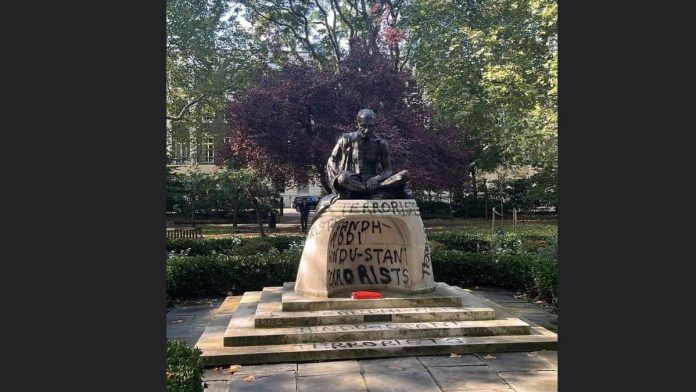New Delhi: Three days before World Non-Violence Day, Mahatma Gandhi’s statue in London was vandalised, with anti-India slogans scrawled on its plinth.
The bronze statue, unveiled at Tavistock Square in 1968, is of Gandhi seated in a meditative pose. On Monday, its base was found defaced with graffiti reading Gandhi-Modi Hindustani Terrorists.
The High Commission of India in Britain strongly condemned the vandalism, calling it “a violent attack on the idea of nonviolence,” and said it had taken up the matter with local authorities.
The incident brings back memories of similar cases involving the defacement of Gandhi’s statue across the world. So why has Gandhi drawn such ire, especially over the last two decades?
South Africa was the crucible in which Gandhi’s philosophy of non-violence was forged, and he spent 20 years campaigning for the rights of Indian people there. But in 2015, his statue in Johannesburg was splashed with white paint. The man behind it, Molese Maile, was part of a group that carried placards reading ‘Racist Gandhi Must Fall. At the time, the hashtag #GandhiMustFall also circulated widely on social media.
A similar charge was levelled in 2018, when a Gandhi statue at the University of Ghana was removed—barely two years after it had been unveiled by then president Pranab Mukherjee. This came after a petition that alleged Gandhi was “racist” and African leaders should be given pride of place instead.
Two years on, a row broke out in England. In 2020, more than 5,000 people signed a petition to take down the Gandhi statue in Leicester, accusing him of being a fascist, racist, and sexual predator. The same statue had earlier been vandalised in 2014 with graffiti referring to the 1984 Golden Temple attack.
In 2021, a life-sized bronze Gandhi gifted by India was vandalised with a power tool in Melbourne, just hours after then prime minister Scott Morrison inaugurated it at the Australian Indian Community Centre in Rowville. “It is disgraceful and extremely disappointing to see this level of disrespect,” Morrison said.
Gandhi statues have faced attacks in India too.
In 2023, Gandhi’s statue in Chitradurga, Karnataka, was damaged by two men; their parents later said they did this under the influence of alcohol. Chief Minister Siddaramaiah called it an act of “anti-nationals”.
In Bihar—the state where Gandhi became Mahatma—unknown miscreants broke the nose, face, and ear of another statue in 2024.
Statues have become a site of Gandhi’s contested legacy.
Also Read: ‘Gandhiji, I have no homeland’—When Ambedkar said Dalits can’t depend on Congress
An imperfect Gandhi
The targeting of Gandhi’s statues has become more frequent in the past two decades, especially after some scholars have interpreted the leader’s stands and actions as racist, based on his stay in South Africa.
“Gandhi has become a controversial figure in anti-racist and anti-colonial movements across the globe,” wrote Dolly Kikon and Hari Bapuji in an article titled Understanding modern attacks on Gandhi.
They argued that Gandhi’s ‘racist’ past is tied to global justice movements like Black Lives Matter, where he is seen as one of many historical figures representing “anti-Black racism on Black people, on Black bodies.”
A 2019 petition against erecting a Gandhi statue in Manchester noted he used the words “kaffirs” and “lazy” to refer to Black people, citing the book The South African Gandhi by Ashwin Desai and Goolam Vahed. The 2015 book also argued that his attitude toward Africans often mirrored that of the British.
Gandhi’s grandson and biographer Rajmohan Gandhi has also acknowledged some of these charges. In Gandhi: The Man, His People, and the Empire, he cited a passage where Gandhi, describing his time in a South African jail, wrote: “Many of the native prisoners are only one degree removed from the animal and often created rows and fought among themselves.”
In his article Why attacks on Mahatma Gandhi are good, Rajmohan Gandhi wrote that when his grandfather arrived in South Africa, “he was undoubtedly at times ignorant and prejudiced about South Africa’s blacks.”
Yet he also noted: “Gandhi too was an imperfect human being, but imperfect Gandhi was more radical and progressive than most contemporary compatriots.”
And he reminded readers why the attacks mattered: “Attacks on Gandhi should be welcomed, for they offer an opportunity to recall the things Gandhi stood for.”
(Edited by Asavari Singh)







This recent one was definitely done by a Pakistani. Who writes “Hindustani” ? I have only seen this word used by Pakistanis.